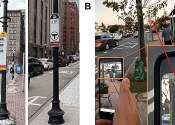New app effectively aids blind and visually impaired commuters in finding bus stops
A team of researchers from Mass Eye and Ear have developed a micro-navigation smartphone app to provide assistance to those who are blind or visually impaired (BVI) in finding their bus stops, and a new study published in ...
Jan 29, 2024
0
22









